
Sep 28, 2021 | Freediving, Meditation
The term “Relax “gets banded around a lot especially in freediving circles, “just relax, take a deep breath” or “you just need to be more relaxed” now this is valid and all well and good unless you are like my type A personality New Yorker friend who internally screams “I’m trying to f**king relax”. This was interesting to me as she has a lot of physical yoga training yet this didn’t necessarily translate into knowing how to relax.
During our instructor course we highlight to candidates the importance of not just telling people to relax but rather giving them the tools to do so, thankfully there are a lot at our disposal and I want to focus on just one of them The Body Scan.
Chances are if you’re reading this you are either doing so on your phone or else laptop. It’s also likely that it’s during down time for you, when theoretically you should be relaxing but are you?
I’d like you to try a little exercise. Stay in the exact position you’re in now, no need to move a muscle.
Scan your body head to toe, is your face soft, jaw relaxed how are you holding your shoulders, how about your posture and your breathing? Chances are that you’re noticing a lot of tension in the body that you would have continued to be unaware of had you not taken time to pay attention.
Now adjust your body position take a couple of deep breaths and have a little shake out to loosen things up. Again scan your body, but this time see if you can let go and soften any areas of tension you come across, release muscles that are activated that don’t need to be. See if you can reach subtler levels of awareness real sensations everything from the sun or wind on your face, the touch of material on your skin , or your breath as it comes in and out of your nose. Whatever you feel in the moment, acknowledge it then move on to another part of the body. Repeat this head to toe several times.
This doesn’t have to just be a one off exercise, better to check in with yourself throughout the day, at home, work, in the car or simply whenever the thought to do so comes to mind or you need to recentre yourself.
I use the “body scan” during my freefall, the part of the dive where a freediver stops kicking, allows gravity to take over and effortlessly sleeps their way down to the bottom. I’ll often notice my shoulders are tense, my quads, stomach and I constantly move through my body letting go. This also has the added benefit of keeping my mind routed in the present and helps to dispel any negative thoughts that might creep in.
Releasing tension from the body can also help relax the mind; this is what yogis discovered centuries ago and is why we reach such deep levels of relaxation in Shavasana, the post yoga meditation. What a lot of people don’t realise though that this actually works the other way too.
A couple of years ago I was at a 3 day Vipssana retreat, usually the courses are 10 days, however, this was just a refresher for old students to help maintain practice.
Anyhow my point is I have always had chronically tight hamstrings, mainly due to years of neglect but I can also remember even as a young child struggling to touch my toes. Now prior to the retreat I was doing a lot of yoga, which was helping to gain some range of movement but what I didn’t expect was what happened after the retreat.
When I went back to my morning yoga routine I realised that I’d gained a lot of flexibility despite having suspended all yoga and stretching during the retreat. What I had been doing though was meditating for 10 hrs a day, calming my mind, scanning my body and I believe this released tension that I was holding. I would normally have brushed this off as a case of having been sitting cross legged for 3 days and maybe it helped open my hips, however, I have done 3 day and several 10 day retreats before and never experienced this from sitting alone.
What we do with the body affects the mind and calming the mind can also affect the body in a continuous feedback loop. Tapping into this awareness can give us powerful tools to help us in life. More than ever it’s important that we work with these simple techniques to counter the fast paced crazy world we’re living in.
If you’re a freediver then congratulations you’re already ahead of the curve and next time your instructor tells you to relax you’ll hopefully have a better idea of what they actually mean!
Be kind to yourself
Kwab
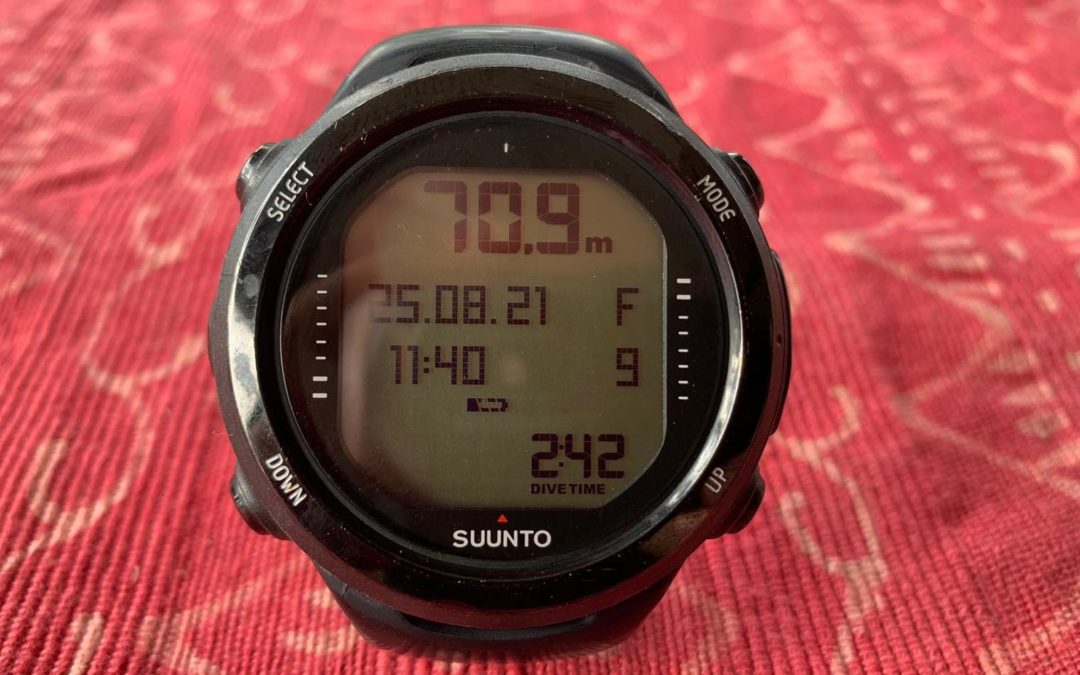
Sep 3, 2021 | Freediving
We say it, we hear it , but what does it really mean? ….. Yes I can already hear calls of “horseshit” from some of my friends but please bear with me ;0)
Freediving takes many forms and covers everything from snorkeling 0 – 5m to deep elite divers going to 130m+. For many of our brethren it’s very much about achieving a certain depth or record and we admire and support this, however, for us it’s “not about the numbers.”
So what do we at Apneista mean when we say it’s not about the numbers and is it even true? Certainly we all enjoy reaching a new PB, who doesn’t like to see 20m, 30m 70m or any nice new round number on their dive computer? We also teach the Molchanov system alongside our own and for this there are specific depth, time and distance requirements to reach. Our instructors all love doing deep dives and I personally plan to continue to train and explore my limits. So it would seem that we have been spending a little too much time in woo woo land if we then express “numbers don’t matter “ or “we’re not interested in depths” the latter of which is most certainly untrue.
So with the above ramble out of the way we can now look at what we actually do mean and give some justification for why we’re often heard spouting such untruths.
When we established the Apneista teaching system one of our driving motivations was the connection that Matt and I saw between freediving and Meditation. I still haven’t found an activity that makes me focus my attention in the present quite like breath holding, I love doing deep dives and I’m continually amazed at what a powerful tool this is for accessing a deep meditative state. It is this experience that we feel is more valuable than any PB or number on a watch
If we are constantly trying to improve or to reach a specific goal the danger is that we can miss out on this state of just being present and allowing ourselves to be complete and still in the moment.
Ironically his can often stand between us and our goals . Forcing dives or trying to “push through’’ doesn’t really work with freediving, especially in the depth disciplines, ok maybe elite level athletes can do this but it can also lead to over training, injury and even loss of interest in an activity once loved.
Now observing this at the beginner/intermediate level its just plain ugly. Watching someone forcing themselves down to the bottom of the line, touching the tennis ball (like they will get a prize for doing so) before a slightly panicked and rushed ascent. “Congratulations you did 20m”, however, no amount of high fiving takes away from the fact that they were absolutely not in the present moment and most probably the dive felt horrible!
Contrast this to a diver taking their last breath, eyes closed or in soft focus, smiling, slowly pulling down the line, feeling the water on their face, the rope in their hands, scanning their bodies, releasing tensions and boop! “Wow I’m already at the end!” Slow relaxed pull, glide and pull back to the surface, feeling the sun on their face, smiling. Get the picture?
If your diving feels like I’ve just described then great you’ve likely got a good instructor. As well as good technique they are teaching you to feel the water, your dives – “progress” should be measured in comfort as well as depth.
If you’re experiencing the former, well then maybe question your motives, your coach, shorten the line and get those dives feeling good again.
So this is what we mean when we say it’s not about the numbers, goal setting is good, can provide motivation and allows for a structured approach to training, but keep it in perspective. 20m, 40m 60m etc. are all just numbers that will come and go. Once you pass them they will no longer seem significant so don’t give them the power over you now.
Progress slowly, safely, enjoy your dives and remember it’s “not about the numbers.”
Look after each other
Kwab
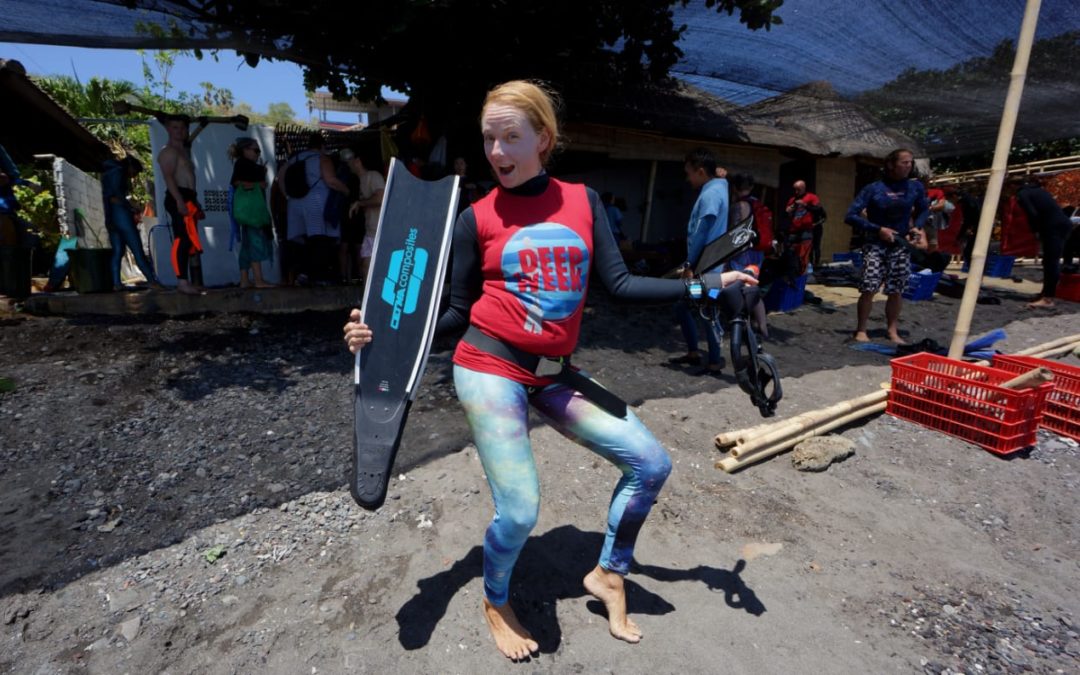
Nov 17, 2019 | Freediving
Well ladies and gentlemen of the underwater world, it’s official; November 2019 Deep Week was the largest non-competitive freediving event in the history of the universe and it was held in the sleepy fishing town of Amed in East Bali.
For those of you that don’t know Deep Week, it’s a congregation of freediving students, instructors and celebrities that all converge on one location a few times a year to hang out, train, dive, learn from and get deep with each other!

Image: Francisco Mesina (@francisco_mesina_films)
Headed by Australian freediving champion Adam Stern, Deep Week has become increasingly popular and this week’s was the largest Deep Week yet. With 111 students, 67 instructors and four freediving celebrities, it really was a smorgasbord of freediving fun, logistically achieved through the amazing efforts of the Apneista and Blue Earth Village crews!
In what was probably the smoothest Deep Week yet there were no incidents and the safety crew had an easy week spending most of their time sunbaking on the paddleboards whilst debating quantum physics and reciting Machiavelli. The conditions were virtually perfect inside Jemeluk bay – as usual – and divers were well protected from the spring tides and strong winds we experienced during the week. Visibility was between 20 and 30m with the average water temperature sitting around 30C. November is always a great time to dive in Amed as the water has warmed up again after winter but the rain hasn’t spoilt the visibility yet!
Joining Adam was New Zealand freediving superstar and 102m Dynamic No-Fins world record holder, William Trubridge. William held workshops on No-Fins technique, maximising MDR and lung volume and equalisation it was fantastic to learn from him and have him visit Amed. Hopefully we’ll see him again soon!
Also visiting were Ukrainian world record holder Natalia Zharkova who held workshops in bi-fins technique, training programs, diet and equalisation, and Molchanovs pro instructor Vitomir Maricic who helped people solve their problems throughout the week as well. A big thanks to all of our visiting celebrities for giving their time to help everyone out.
There were plenty of highlights throughout the week but probably none more impressive than the lucky students that were visited by first a mola mola and then a pod of dolphins on the boat dive. Equally impressive was Adam Stern’s fin rescue in Jemeluk Bay (third video in the Instagram post below). When you lose a fin in 45m of water, who ya’ gonna call?
https://www.instagram.com/p/B4rvaCNAk0h/
As usual, the wreck diving was a big hit with the students and in their free time students took advantage of the amazing wreck diving that East Bali has to offer, with past visitors to Amed particularly keen to take a look at Amed’s fourth and newest wreck!
The lap pool and the static pool are both now open in Blue Earth Village so Deepweekers took full advantage of the great facilities to train and test themselves in the pool disciplines.
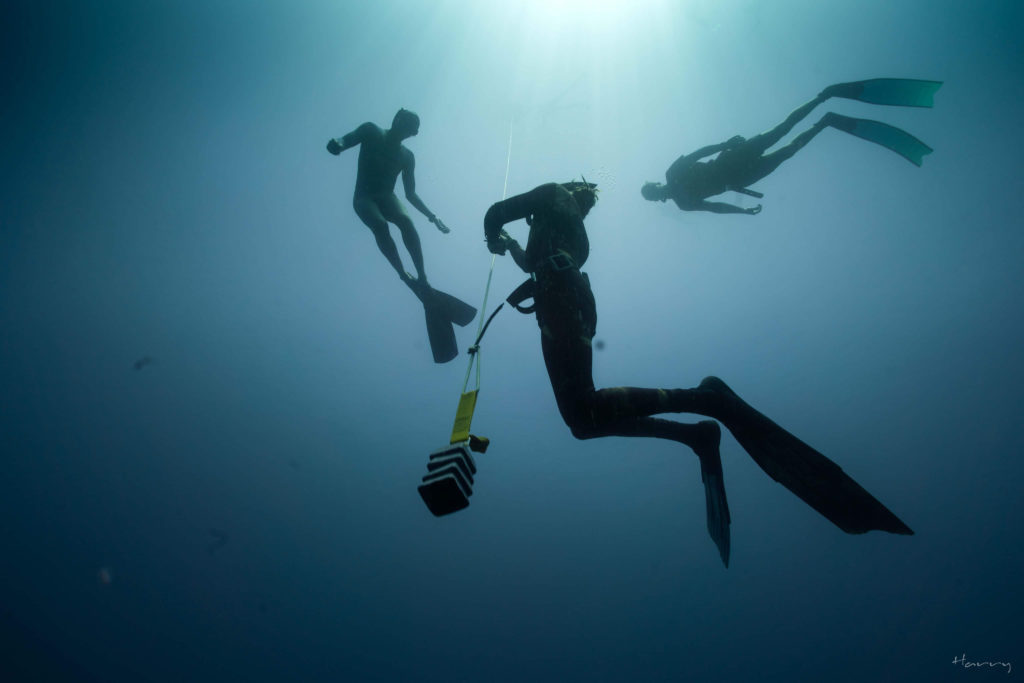
Image: Harry Webber
When you combine all of this diving with the hands-on training and problem solving on offer during deep week as well as yoga, crossfit and meditation in the mornings and evenings it’s no wonder Deep Week is becoming increasingly more popular as word continues to get out about this wonderful festival.
The next Deep Week begins this Saturday in Amed and there are a handful of last-minute places available so if you’re interested get in touch with Adam Stern ASAP. There’s also another Deep Week in Amed in April next year which is filling up quickly too so get in touch with Adam if you’re interested.
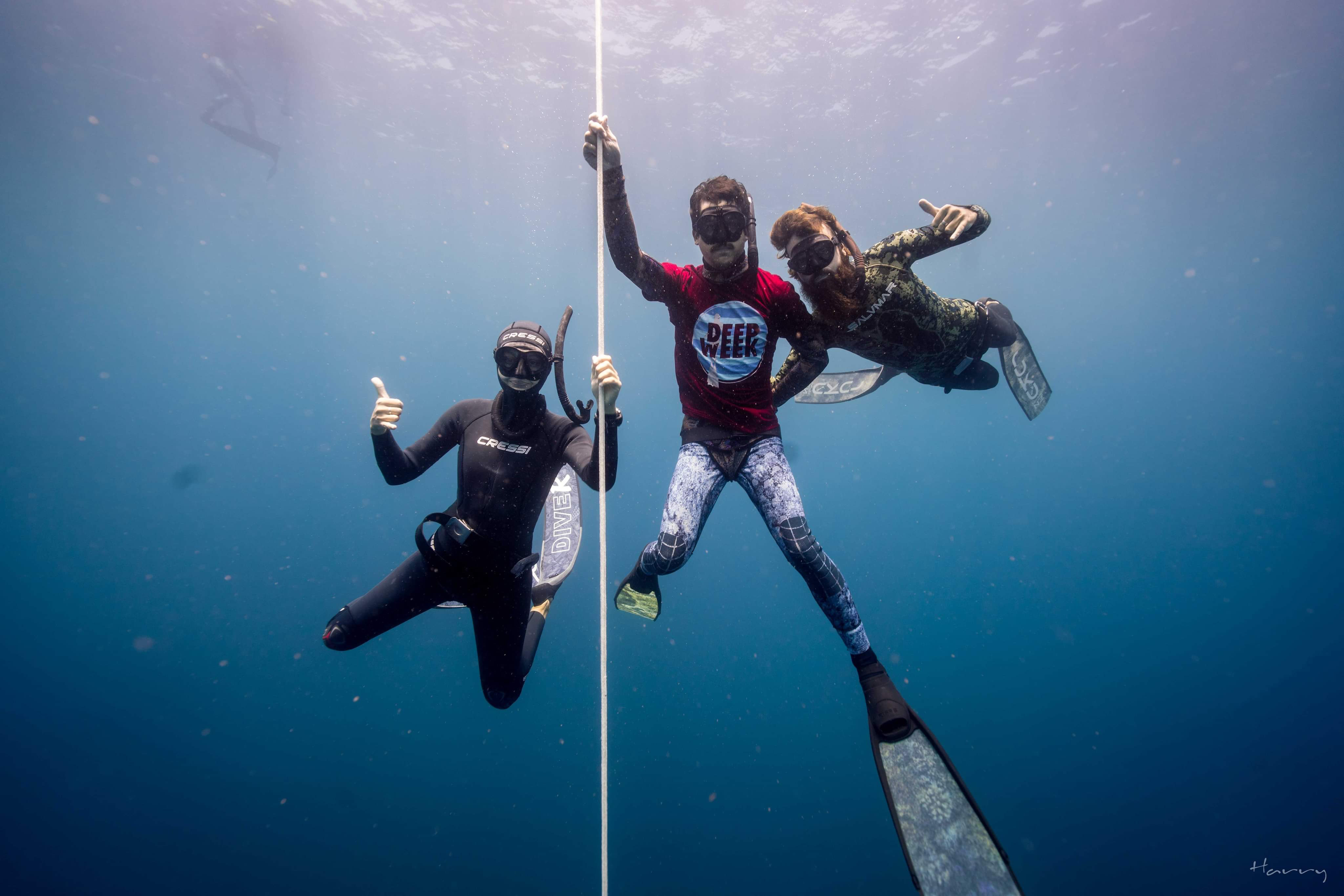
Image: Harry Webber
So with all that said and done all that’s left now is to rock the Deep Week closing party tonight but unfortunately for you guys there’s no cameras allowed because as any Deep Weeker knows, what happens at the Deep Week party, stays at the Deep Week party!
See you at the next one!
Written by Jereme Lane
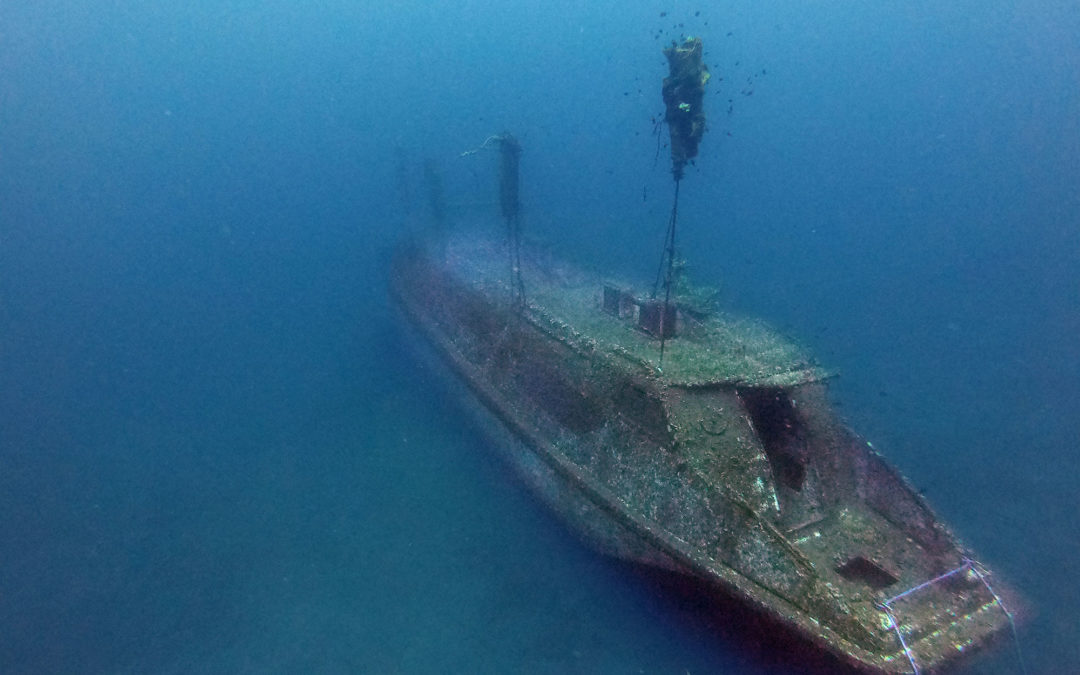
Nov 15, 2019 | Freediving
Amed is famous in the one-breath world for more than just freediving courses and freedive instructor training, it’s also known for its world class wreck diving. Until recently Amed had two wrecks in close proximity to shore that are easy for snorkelers, freedivers and scuba divers alike, plus a third wreck available for advanced freedivers and scuba divers (Amed wreck guide). But that all changed recently when a fastboat destined to start taking passengers between Amed and the Gili Islands sank on its mooring.
Nobody knows what actually happened with the theories ranging from cheap manufacturing all the way through to disgruntled aliens, but the most important thing to remember is that nobody was onboard when it went down. Amen. The other important thing to remember is that this new wreck is VERY conveniently located on the edge of town!
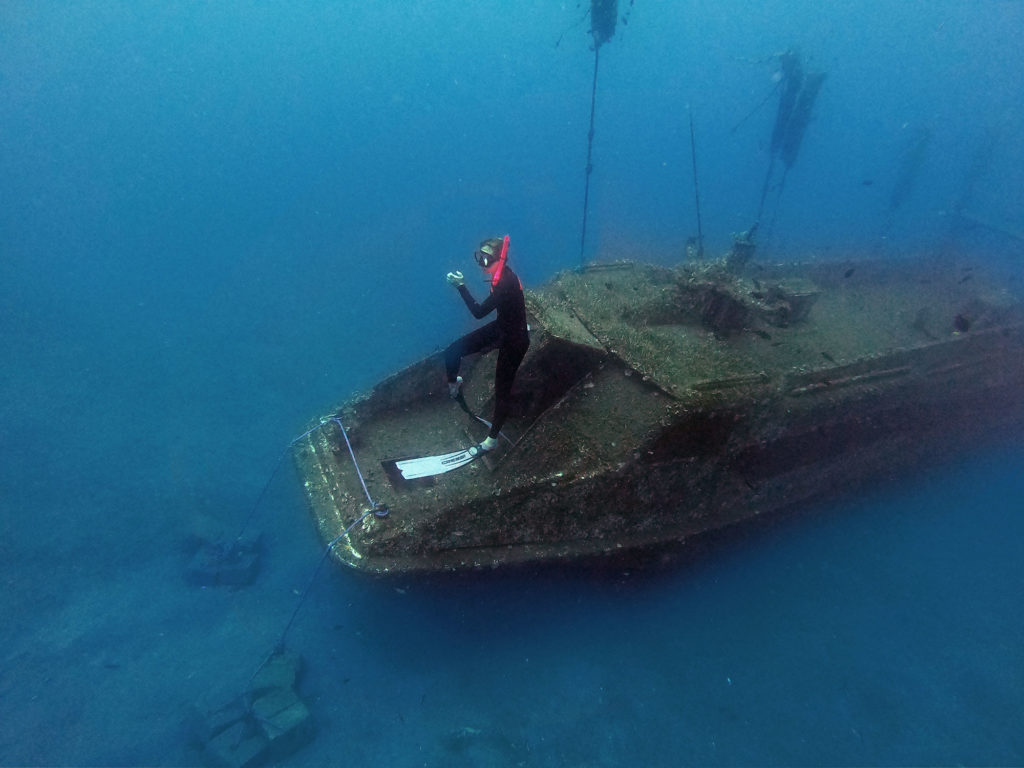
Image: Glenda Duarte (@glendarama)
For those of you that know Amed, you can find the new wreck located at the junction of Amed and Melasti beaches. This is the corner where Green Lemon Warung and Pacha Beach Rasta Bar are located. No, not the Rasta Bar near Indomaret, the other one. No, not Warung Kedai, that’s a rasta bar but it’s not called Rasta Bar. Yep that one.
Now there’s been quite a bit of conjecture about the depth of the wreck but we can confirm as of today that the deepest point of the hull is at 25 metres and the highest point of the roof is at 22 metres (tide depending). This makes it a very viable proposition for freedivers and anyone who has passed their level 2 course should be able to at least get down for a look at the outside, if not sit in the captain’s seat and pretend you’re driving or a passenger commuting to your underwater day-job…
https://www.instagram.com/p/B1iWQbYlw5u/
The fast boat is already covered in plenty of marine slime and debris and as you can see in the image below, seagrasses have taken nicely to the hull. This has already brought schools of small fish that are taking up residence in amongst the wreck. Rays, lion fish and some species of surgeons have also been spotted around the wreck so things are looking good. This particular part of the coast is one of the few patches without much natural reef so no doubt being the biggest piece of reef in the area is bound to start attracting more fish and crustaceans over the next few months and years.
The wreck originally sank in 17m of water and has now moved it’s way down to 25m of water so let’s hope that it doesn’t go too much further and we can continue to enjoy it for years to come!
For further information about the Pacha Wreck, the other three wrecks in East Bali or free dive courses in bali please contact us.
Written by Jereme Lane
Cover image by Glenda Duarte
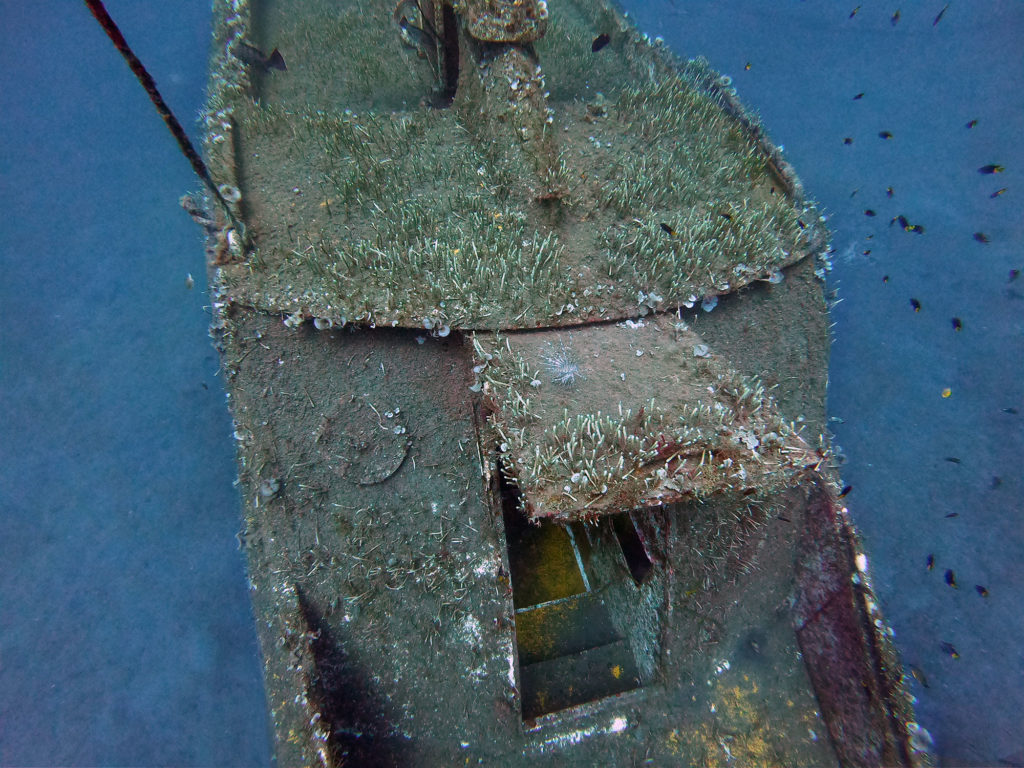
Image: Glenda Duarte (@glendarama)

Nov 15, 2019 | Freediving
One of the most common questions from newcomers to the sport is the question of freediving records. “Who is the deepest freediver in the world?” is a very common question and the answer can be quite complicated. Freediving has some interesting and sometimes confusing terms and rules surrounding the different ‘disciplines’ or competition types. Free immersion, constant weight, dynamic, static… fancy words but what the hell do they actually mean?
We’re not exactly sure who to thank for our confusing freediving terms but whoever took the simple art of diving on one breath and turned it into the linguistic dog’s breakfast that it’s become has got some explaining to do!
Anyway, we’ve decided to make it nice and simple for you and explain the most common disciplines you’re likely to encounter as an everyday freediver, and what the freediving record is for each one.
Disclaimer: Apneista advises that freediving is a holistic spiritual experience involving body and mind and thus records and personal bests (PBs) are not important to the enjoyment of the sport.
FREEDIVING RECORDS FOR POOL DISCIPLINES
Dynamic Apnea
Let’s start with the easiest ones. The definition of the word ‘dynamic – and its variations from other languages – essentially means, pertaining to force producing motion (think the opposite of ‘static’). And, apnea means, a temporary cessation of breathing, or simply, holding ones breath underwater.
So, complicated linguistics aside, Dynamic Apnea, or simply ‘dynamic’, is the name that we give in freediving to the discipline of swimming underwater in the pool on one breath measured in horizontal distance.
Remember growing up when you and your siblings used to hold highly-competitive tournaments to see who could do the most laps of the backyard pool on one breath? Well you probably didn’t know it at the time, but you were actually competing in a Dynamic freediving competition.
There are two types of Dynamic disciplines; with fins and without.
Dynamic with fins (DYN)
Men’s world record: Mateusz Malina & Giorgos Panagiotakis (300m)
Women’s world record: Magdalena Solich (243m)
https://www.youtube.com/watch?v=RtBnhCi94l0
Dynamic no fins (DNF)
Men’s world record: Mateusz Malina (244m)
Women’s world record: Magdalena Solich (191m)
Static Apnea (STA)
And as you’ve probably worked out by now, Static apnea, or just ‘static’, is the discipline of in-water breath hold without moving. Different to all the other freediving disciplines in that it doesn’t require any diving or swimming at all, the contestants simply float whilst holding their breath for as long as they possibly can. Of all the disciplines static has a reputation as being very challenging for the mind because you basically hold your breath while carbon dioxide wreaks havoc on your brain as your mind begs you to take a breath. Oh, and it’s also not much of a spectator’s sport as you’ll see in the 10 minute video below but there is a certain level of epic, jaw-dropping respect for those in the top echelons of static.
Men’s world record: Stéphane Mifsud (11:35)
Women’s world record: Natalia Molchanova (9:02)
https://www.youtube.com/watch?v=pvXyt60c6qI
Note: Longer breath holds have occurred outside official freedive competitions, however these include the use of techniques that aren’t allowed in freedive competitions. The Guinness book of records longest single voluntary breath hold is 24 mins and 3 seconds.
FREEDIVING RECORDS FOR OPEN WATER DISCIPLINES
Free Immersion (FIM)
Free immersion is the discipline that involves a diver descending a vertical line (rope with a bottom weight to hold it vertical) upside down using only one’s hands to propel oneself down the line to the end and then back up again. If you’ve ever seen a freediver with their hands on a rope heading down head first, then you have witnessed free immersion.
Free Immersion is considered by some to be the least pure of the depth disciplines because it provides unnatural assistance however, it’s because of the assistance provided by way of the rope pull movement that free immersion is – and always will be – a popular way to learn how to freedive as it simplifies the process of achieving depth.
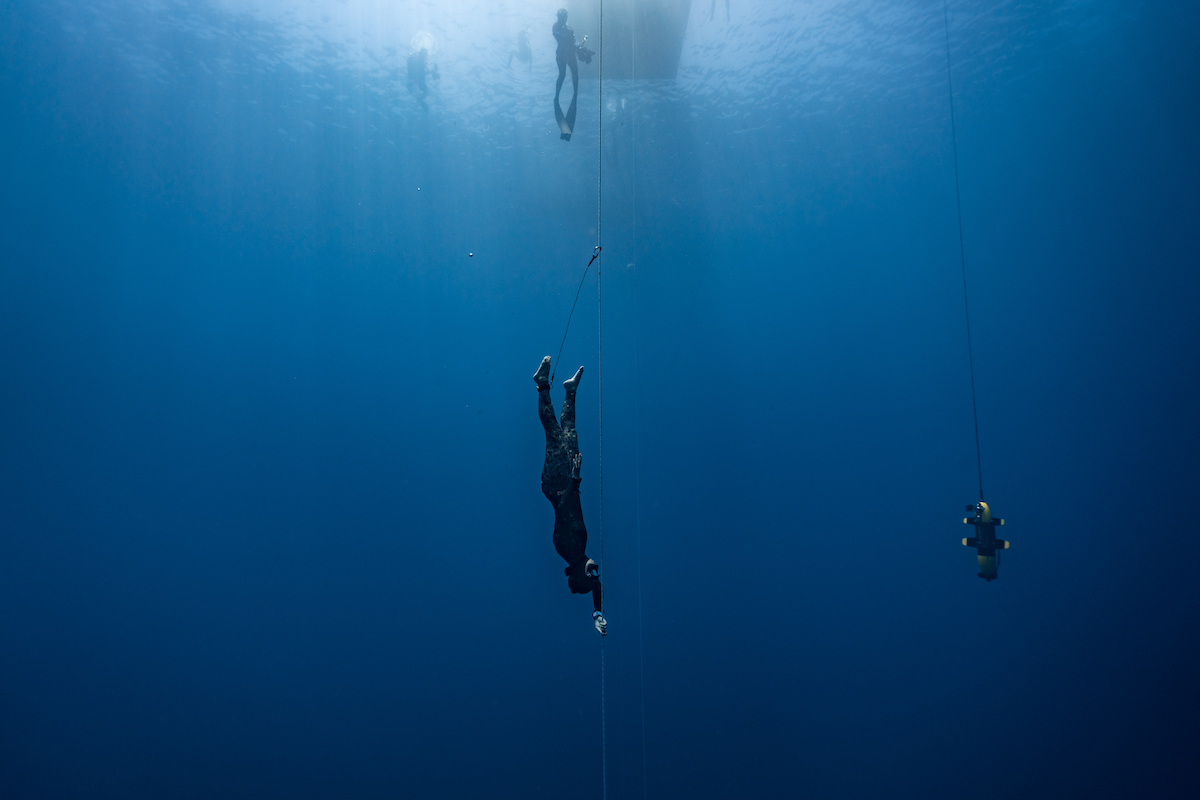
Image: Daan Verhoeven (@daanverhoevenfreediver)
Men’s world record: Alexey Molchanov (125m)
Women’s world record: Sayuri Kinoshita (97m)
Constant Weight with Fins (CWT)

Image: Trista Fontana (@underwater_explorer)
Constant weight with fins or just ‘constant weight’ is a dive straight up and down the line unassisted by anything other than fins (bifins or a monofin). The diver is allowed one pull of the line at the bottom before they begin their ascent.
Men’s world record: Alexey Molchanov (130m)
Women’s world record: Alessia Zecchini (107m)
https://www.youtube.com/watch?v=SMcB9npc8FU
Constant Weight No Fins (CNF)
As you can probably gather, constant weight no fins, or just ‘no fins’ is the discipline that many consider to be the purest of them all. Using… well, no fins, the diver makes his way down and then up the line again without the assistance of a mermaid’s tail or a set of duck’s feet.
Divers use a special type of swimming technique imaginatively known as ‘no fins’ (yes the same as the ‘no fins’ in the pool but with a minor navigational modification) which is a combination of sweeping the arms and displacing water to pull oneself down through the water, combined with leg movements that somewhat resembles a frog’s kick. No fins relies on impeccable technique to maximise the distance travelled through the water to energy used and this is why it is considered to be the most pure of the disciplines.
Legend has it that there is a beautiful mermaid waiting for any man that breaks the 100m no fins barrier. William Trubridge did that in 2016 but refused to answer our deeply intimate questions about the encounter. We will get the details out of him at Deep Week in November 2019!

Image: Trista Fontana (@underwater_explorer)
Men’s world record: William Trubridge (102m)
Women’s world record: Alessia Zecchini (73m)
Variable Weight
Now we’re getting into the fancy disciplines where depth junkies use all sorts of techniques to get themselves as deep as possible. Variable weight basically means that the diver can change his/her weight during the dive. This equates to using some sort of weight to pull the contestant down to a set depth before they make their own way back up to the surface.
This discipline was made famous by mafia families disposing of victim’s bodies using concrete blocks to drag the bodies down to the sea floor in deep water but has since been refined by freedivers to release the weight and ascend to the surface to breath again and continue with everyday life above water.
Men’s world record: Stavros Kastrinakis (146m)
Women’s world record: Nanja van der Broek (130m)
https://www.youtube.com/watch?v=OwETZ73aS2A
No limits
And last but certainly not least is the ‘no limits’ discipline. As the name implies, there aren’t too many rules for this one and if you can go down deeper than anyone else and come back up again, they’ll hang a medal on you when you wake up. Actually, there’s no medals for no limits anymore because AIDA doesn’t want anything to do with it, but you will have the honour of being the answer to a pub quiz question for centuries to come… or until somebody crazier than you comes along.
No talk of crazy and the no limits discipline would be complete without a mention for Herbert Nitsch who has broken 33 world records in his career and is the current ‘deepest man on earth’ at 253m.
In 2012 Herbert descended very rapidly on a modified underwater Jamaican bob sled and ascended using an air balloon. Unfortunately, during this record-breaking dive he had an ‘unplanned nap’ on the way up due to nitrogen narcosis and didn’t complete his safety stop after the rescue divers feared for his safety and brought him up early. This caused him to suffer decompression sickness resulting in several brain strokes.
Herbert was told he would never walk again but has defied doctors and made an incredible recovery after heavy rehabilitation. He still suffers balance and coordination issues on land however, he does not experience those issues underwater.
World record: Herbert Nitsch (253m)
https://www.youtube.com/watch?v=m1B9Un84i4w
*Note: The records used here are from the International Association for the Development of Apnea (AIDA) which tracks and keeps records in the most commonly used freediving disciplines mentioned above.
For more information on freediving courses please get in touch.
Written by Jereme Lane

Aug 21, 2019 | Freediving
When divers think of Amed, they think of wrecks including of course the world famous Liberty wreck. Regardless of whether you’re a freediver or a scuba diver, there’s a variety of wrecks to suit your experience and skill level situated relatively close to the town of Amed. When you combine the quality of wreck diving on offer with the mild dry season climate and amazing visibility at this time of year, it’s easy to see why Amed is starting to attract more and more international visitors. So, with this in mind we’ve put together a wreck diving guide to help you plan your wreck diving adventure in Amed!
LIBERTY WRECK – Tulamben (20 minutes from Amed)
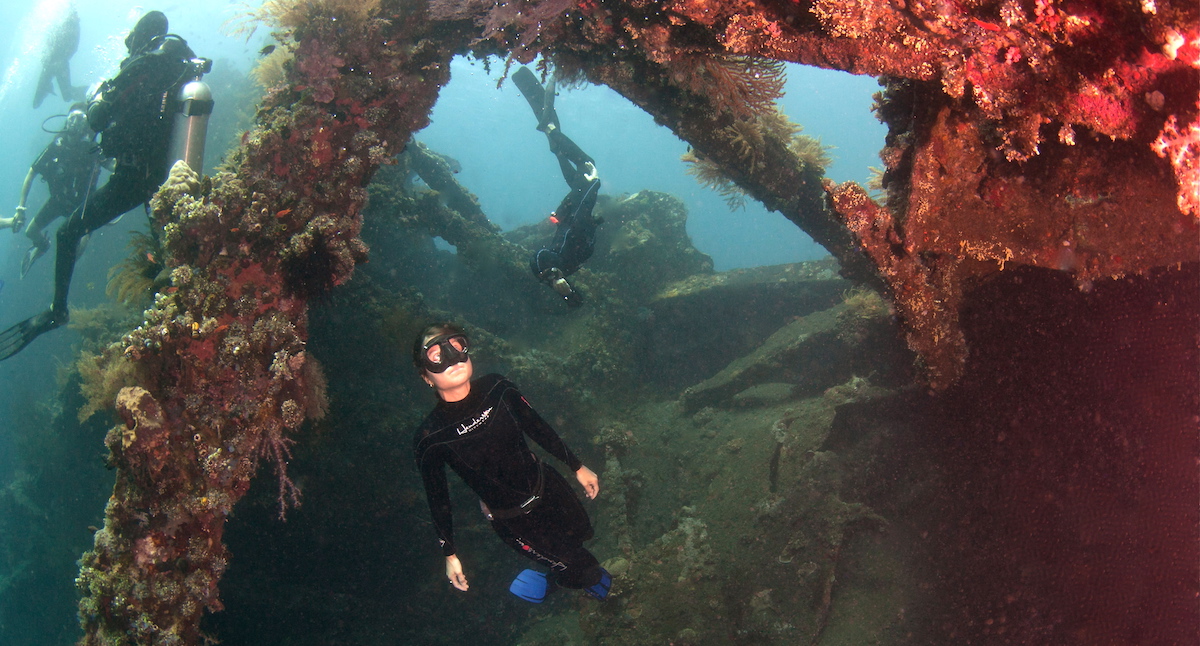
Image: Apneista
Undoubtedly, the USAT (United States Army Transport) Liberty is the most famous of Amed’s four wrecks and is world famous in wreck diving circles. The story of the Liberty goes that in January 1942 the Liberty was en route from Australia to the Philippines with cargo when it was torpedoed by a Japanese submarine near Bali. Taking on water and unable to get all the way to Singaraja, the ship was beached in Tulamben so that the cargo could be salvaged.
The ship then sat on the beach at Tulamben for a couple of decades before nearby volcano Mount Agung erupted in 1963 and the resulting tremors slid the Liberty down into the water where it currently resides on the sand 100 metres or so from shore.
With the top of the ship being around four metres deep (tide depending) and the bottom in over 30 metres, a large part of the Liberty’s attraction is that it is open to everyone from beginners through to advanced divers. While it can get crowded during high season, particularly with scuba divers, the hull is 125 metres long so there is plenty of ship to explore.
After the beaching in WW2 the ship was stripped of anything of any value over the next few years and so while the hull and interior are quite bare of actual ship parts, this makes it very easy and safe to dive without worrying too much about banging your head on a doorway or stairwell.
Oh, and of course no talk of wreck diving is complete without a swimthrough or two and the Liberty has plenty at various depths, meaning the Liberty is probably your safest bet if you’re looking for 100 likes on Insta. It’s also a load of fun without the Gopro, and the biggest swimthrough in the cargo hold starts at about 10 metres with a massive opening making it perfect for level 1 and 2 freedivers. If you’ve got enough breath hold, stop and have a quick look around on your way through because there’s always a big snapper or two hanging out in there!

Artwork by Mike Vam de Vem, 2017
While any huge man-made piece of steel reef will be an attractant for fish life, it is no doubt thanks to the protected zone surrounding the Liberty that the fish life here rivals anywhere in Bali. You can find all the usual colourful reef species to this area however, it’s the sheer numbers of large demersal fish that makes the Liberty truly special, with plenty of diver-friendly snapper, groupers and parrot fish.
Early mornings are great for sighting the resident humphead parrot fish that habitually come in to school around the wreck, while those who aren’t afraid to stick their head in small holes and under ledges can often be rewarded with sightings of the large and sometimes timid groupers.
JAPANESE WRECK – Banyuning (15 minutes from Amed)

Image: Harry Webber
The Japanese wreck is the second most popular wreck in the area and at around 20m long is very small in comparison to the Liberty but, as the Japanese wreck afficionados will tell you, what it lacks in size it makes up for in beauty.
Nobody actually knows the reason the wreck is known as the Japanese wreck but the rumour that has the most credibility are that the term Java-nese was mistaken for Japa-nese.
The mystery doesn’t end with the history of the name either, as the actual purpose of the vessel is also cloudy. The wreck is lying on its side with much of the hull, deck and, well pretty much everything else, missing. It could be a fishing boat, a tug or even a small cargo ship but we’ll probably never know for sure.

Image: Harry Webber
Whatever the case the wreck has been there for a long time and wasn’t a mainstay of Amed diving until the road out to Lipah from Amed was upgraded from a goat track to a scooter track and eventually a half decent road by East Bali standards. Nowadays, there’s a carpark, a café and snorkel hire right on the beach next to the wreck. There’s also a few small hotels close by and some people like to stay at this end of East Bali because it’s the quietest part.
Just like the Liberty, a few decades of submerged existence has been very kind to the Japanese wreck’s aesthetics and the hull is covered in some of the most beautiful corals and sponges in the area making it a wreck diving favourite for the area. There’s also plenty of fish, shrimp, rays and other marine life to keep you entertained for a couple of hours.
From the beach, you simply swim out the 50 metres or so to the wreck which begins in a few metres of water making it suitable for all levels including snorkelers.
BOGA wreck – Kubu (30 mins from Amed)
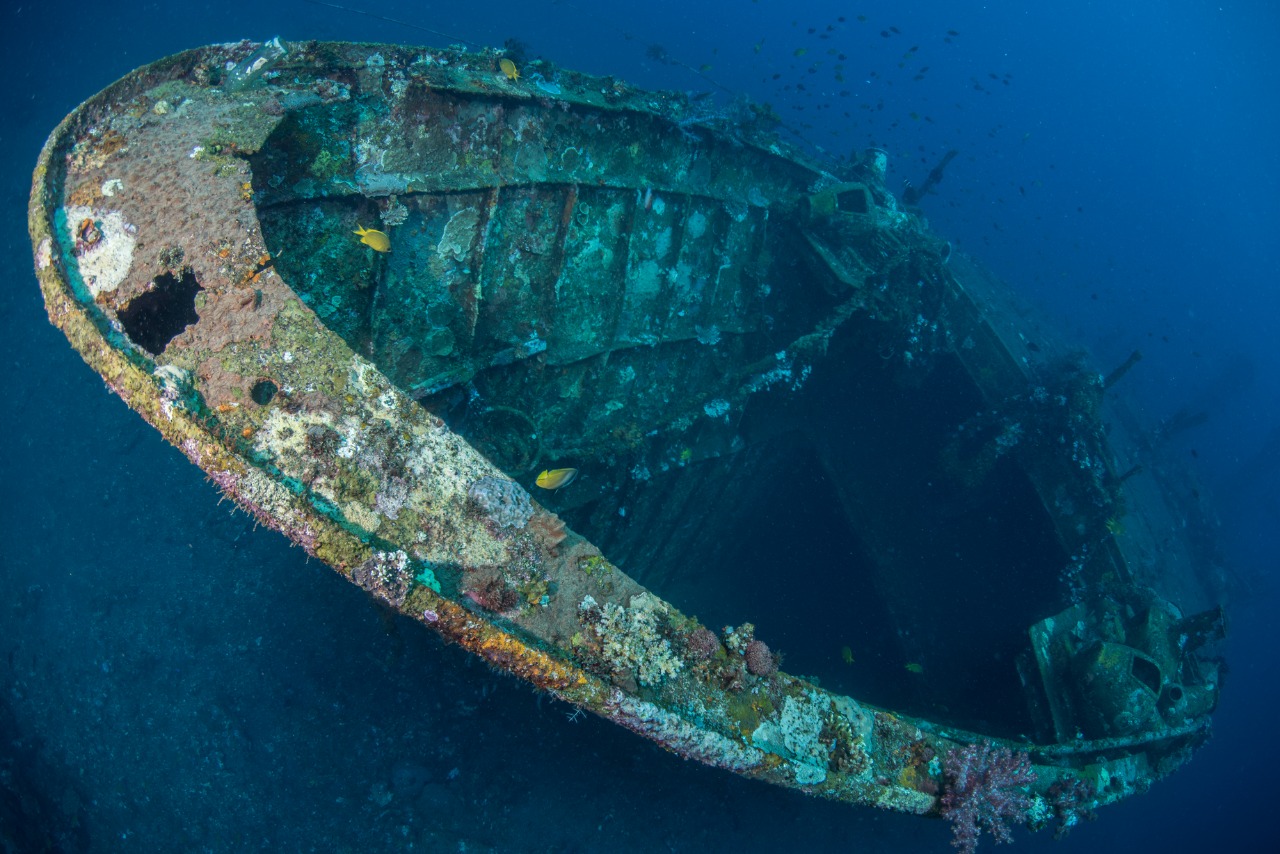
Image: Heather Sutton (@hsexposures)
On the back of the success of the Liberty and Japanese wrecks in bringing tourism opportunities to the Amed area, in 2012 the Boga was sunk off Kubu beach to further cement Bali’s status in the wreck diving world. The Boga was a 40 metre long, 150-tonne Dutch cargo ship before being purchased by the owner of the Bali Relax Hotel and donated to the Karangasem Badung (regency).
In contrast to the Liberty and Japanese wrecks, the hull of the Boga is well and truly intact and provides a great contrast to the other wrecks with its, ‘not being completely decimated by time, torpedoes or seismic activity’ qualities.
The main issue with the Boga and the reason why it’s nowhere near as popular as its neighbouring wrecks is the depth. The Boga was originally placed in the ‘scuba-friendly’ 30-metre-deep range. That meant that the top of the ship was around 13-15 metres deep and the bottom sat around 30-32. However, the Boga apparently didn’t want to sit in that spot and eventually the hull slid and wiggled its way down to sit at 40m, a good challenge for the freedivers.

Image: Heather Sutton (@hsexposures)
The top now sits around 18 metres and when you add in the high current usually experienced in the area this makes it strictly an experienced wreck diving location for both freedivers and scuba divers.
Highlights of the ship include a Volkswagon convertible (yep really), a propeller and a steering wheel which are all very instagrammable for those who can get down to them. There’s also a swimthrough around 28m but often the scuba divers won’t go inside the ship because the current is too strong so freediving must be done with even further care.
There isn’t anywhere near the level of marine life as the nearby Liberty but the Boga can boast that the hull is entirely in tact. So while it doesn’t beat the Liberty at supporting a living reef, it does beat the Liberty at being an actual boat and this has some upsides too!
Amed’s fourth and newest wreck

Image: Glenda Duarte (@glendarama)
Now I’m sure there’s a few people reading this that are thinking to themselves, “that’s it, there’s only three wrecks in Amed. What are they talking about, four wrecks?”
Well ladies and gentlemen, Amed now officially has its fourth wreck! Yes that’s right, and this one is right in the heart of Amed! Click here to read more.
Written by Jereme Lane





















